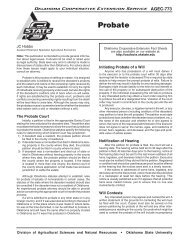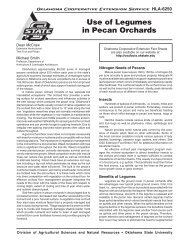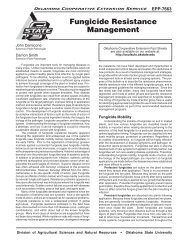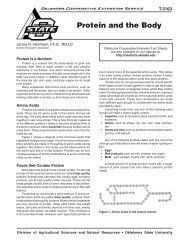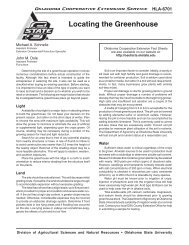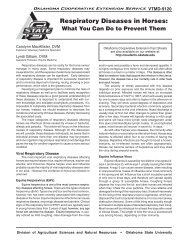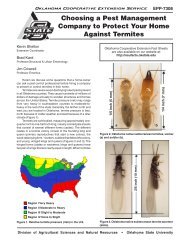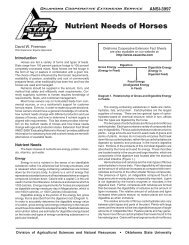EPP-7303 Scorpions - OSU Fact Sheets - Oklahoma State University
EPP-7303 Scorpions - OSU Fact Sheets - Oklahoma State University
EPP-7303 Scorpions - OSU Fact Sheets - Oklahoma State University
You also want an ePaper? Increase the reach of your titles
YUMPU automatically turns print PDFs into web optimized ePapers that Google loves.
After their first molt, young scorpions leave their mother<br />
and begin to fend for themselves. At this time, the young<br />
scorpions are already capable of stinging. It takes about one<br />
year for the young to reach maturity. Depending on the species<br />
and the environmental conditions, scorpions can live for<br />
three to five years.<br />
Scorpion Stings<br />
<strong>Scorpions</strong> are basically shy creatures, aggressive only<br />
towards their prey. They will not sting humans unless they are<br />
handled, stepped on, or otherwise bothered. For most people,<br />
a scorpion sting is slightly more painful than a bee or wasp<br />
sting. The venom can produce considerable pain around the<br />
area of the sting, but swelling is generally limited. In some<br />
people, sensations of numbness and tingling may develop in<br />
the area of the sting for four to six hours. After this time, the<br />
symptoms start to regress and will normally disappear within<br />
24 hours.<br />
A scorpion sting can be treated at home without having<br />
to go to a hospital or physician. However, in the case of<br />
young children or hypersensitive individuals, medical attention<br />
should be sought immediately. The sting of the species<br />
of scorpion we have in <strong>Oklahoma</strong> is not considered to be<br />
lethal and rarely causes few problems. If traveling, however,<br />
remember that there are other species of scorpions that can<br />
be more venomous, especially to the young or elderly. The<br />
majority of the more venomous stings can be treated with an<br />
antivenom. When administered early, this serum has saved<br />
lives.<br />
Treat a scorpion sting by washing the area with soap and<br />
water and applying a cool compress. If the pain is uncomfortable,<br />
an over-the-counter pain reliever such as aspirin or<br />
acetaminophen may be helpful, but you should consult your<br />
physician first. Elevating an affected limb may also provide<br />
some relief. Do not administer any sedatives, such as alcohol.<br />
If swelling or pain persists, or if breathing difficulty occurs,<br />
seek medical attention immediately. Do not take any chances,<br />
especially with small children or the elderly.<br />
Control<br />
It is not practical to control scorpions with insecticides<br />
alone. The most effective way to control scorpions is to eliminate<br />
their habitats and any possible entry ways into the house. By<br />
following these suggestions, you can reduce scorpion habitats<br />
in or around your home:<br />
<strong>EPP</strong>-<strong>7303</strong>-2<br />
• Remove all trash, logs, boards, stones, bricks, and<br />
other objects from around the home.<br />
• Keep the grass closely mowed near the house.<br />
• Store outdoor garbage containers in frames that keep<br />
the containers off the ground.<br />
• Do not bring firewood inside until you’re ready to use<br />
it.<br />
• Place weather-stripping around any loose fitting doors<br />
and windows.<br />
• Plug weep holes in brick veneer homes with pieces<br />
of nylon, scouring pads, or any other small piece of<br />
fine mesh screen.<br />
• Caulk around roof eaves, pipes, and other cracks or<br />
crevices.<br />
• Keep window screens in good repair. Make sure there<br />
are no tears in them and that they fit tightly in the<br />
frames.<br />
• Eliminate any clutter from the attic, garage, and crawlspace.<br />
After following these precautions, you may notice an<br />
increase in scorpion activity in or around your home. This is<br />
because their habitat has been removed and they are looking<br />
for a new place to live. You should then consider treating your<br />
home with chemicals. If scorpions are extremely common in or<br />
around your home, it is suggested that you use a pest control<br />
company to treat the premises. A pest control company will<br />
have the equipment, chemicals, and know-how to treat the<br />
area properly.<br />
When chemical control is needed, properly labeled insecticides<br />
should be applied to baseboards, under furniture,<br />
and all interior and exterior cracks and crevices (pesticides<br />
for homeowner use are provided in <strong>OSU</strong> <strong>Fact</strong> Sheet 7312).<br />
Other areas that will likely need treatment include the attic,<br />
garage, and crawl space. Areas that are in contact with the<br />
soil should also be treated (foundation, siding, porches, etc.).<br />
Treatment must be thorough. It is preferable to use dust formulations<br />
of insecticides in attics, wall voids and crawl spaces.<br />
After completing your clean up and sealing efforts, outdoor<br />
insecticide treatments should help eliminate scorpions before<br />
they gain access into the home.<br />
<strong>Oklahoma</strong> <strong>State</strong> <strong>University</strong>, in compliance with Title VI and VII of the Civil Rights Act of 1964, Executive Order 11246 as amended, Title IX of the Education Amendments of 1972, Americans<br />
with Disabilities Act of 1990, and other federal laws and regulations, does not discriminate on the basis of race, color, national origin, gender, age, religion, disability, or status as a veteran in<br />
any of its policies, practices, or procedures. This includes but is not limited to admissions, employment, financial aid, and educational services.<br />
Issued in furtherance of Cooperative Extension work, acts of May 8 and June 30, 1914, in cooperation with the U.S. Department of Agriculture, Robert E. Whitson, Director of Cooperative<br />
Extension Service, <strong>Oklahoma</strong> <strong>State</strong> <strong>University</strong>, Stillwater, <strong>Oklahoma</strong>. This publication is printed and issued by <strong>Oklahoma</strong> <strong>State</strong> <strong>University</strong> as authorized by the Vice President, Dean, and Director<br />
of the Division of Agricultural Sciences and Natural Resources and has been prepared and distributed at a cost of 20 cents per copy. Revisied 1012 GH




